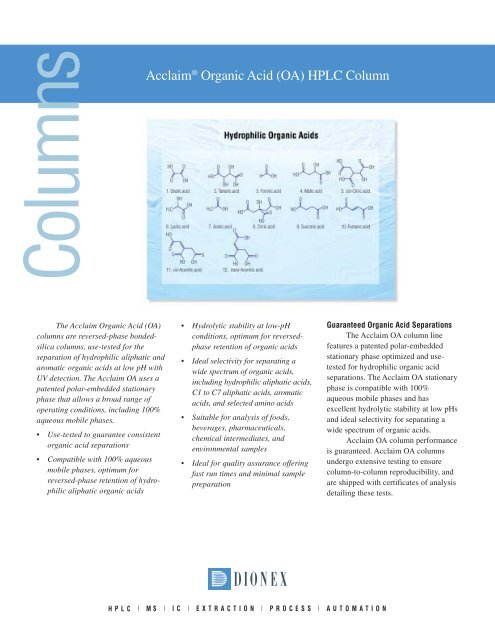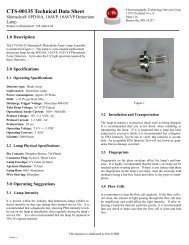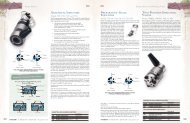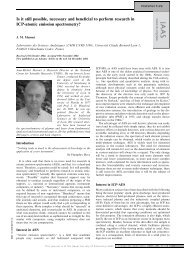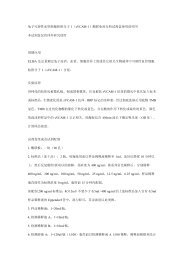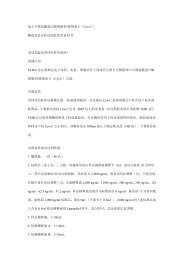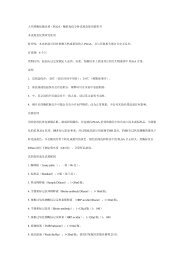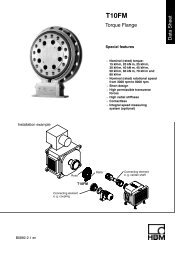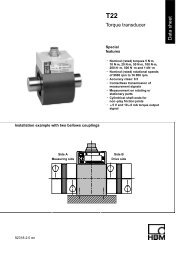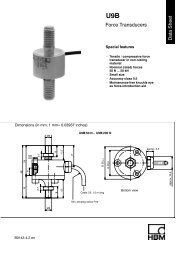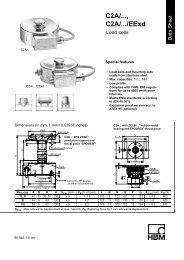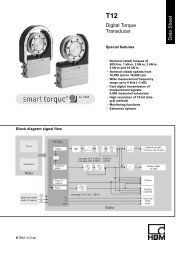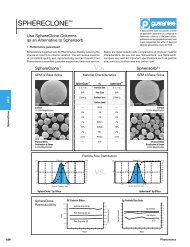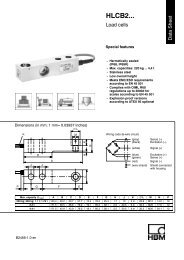Acclaim Organic Acid (OA) HPLC Column Data Sheet - Dionex
Acclaim Organic Acid (OA) HPLC Column Data Sheet - Dionex
Acclaim Organic Acid (OA) HPLC Column Data Sheet - Dionex
You also want an ePaper? Increase the reach of your titles
YUMPU automatically turns print PDFs into web optimized ePapers that Google loves.
<strong>Column</strong>s<br />
<strong>Acclaim</strong> ® <strong>Organic</strong> <strong>Acid</strong> (<strong>OA</strong>) <strong>HPLC</strong> <strong>Column</strong><br />
The <strong>Acclaim</strong> <strong>Organic</strong> <strong>Acid</strong> (<strong>OA</strong>)<br />
columns are reversed-phase bondedsilica<br />
columns, use-tested for the<br />
separation of hydrophilic aliphatic and<br />
aromatic organic acids at low pH with<br />
UV detection. The <strong>Acclaim</strong> <strong>OA</strong> uses a<br />
patented polar-embedded stationary<br />
phase that allows a broad range of<br />
operating conditions, including 100%<br />
aqueous mobile phases.<br />
• Use-tested to guarantee consistent<br />
organic acid separations<br />
• Compatible with 100% aqueous<br />
mobile phases, optimum for<br />
reversed-phase retention of hydrophilic<br />
aliphatic organic acids<br />
• Hydrolytic stability at low-pH<br />
conditions, optimum for reversedphase<br />
retention of organic acids<br />
• Ideal selectivity for separating a<br />
wide spectrum of organic acids,<br />
including hydrophilic aliphatic acids,<br />
C1 to C7 aliphatic acids, aromatic<br />
acids, and selected amino acids<br />
• Suitable for analysis of foods,<br />
beverages, pharmaceuticals,<br />
chemical intermediates, and<br />
environmental samples<br />
• Ideal for quality assurance offering<br />
fast run times and minimal sample<br />
preparation<br />
Guaranteed <strong>Organic</strong> <strong>Acid</strong> Separations<br />
The <strong>Acclaim</strong> <strong>OA</strong> column line<br />
features a patented polar-embedded<br />
stationary phase optimized and usetested<br />
for hydrophilic organic acid<br />
separations. The <strong>Acclaim</strong> <strong>OA</strong> stationary<br />
phase is compatible with 100%<br />
aqueous mobile phases and has<br />
excellent hydrolytic stability at low pHs<br />
and ideal selectivity for separating a<br />
wide spectrum of organic acids.<br />
<strong>Acclaim</strong> <strong>OA</strong> column performance<br />
is guaranteed. <strong>Acclaim</strong> <strong>OA</strong> columns<br />
undergo extensive testing to ensure<br />
column-to-column reproducibility, and<br />
are shipped with certificates of analysis<br />
detailing these tests.
Consistent Performance with 100%<br />
Aqueous Mobile Phases<br />
Due to their solubility properties,<br />
many polar-organic acids are better<br />
retained and resolved on reversed-phase<br />
<strong>HPLC</strong> columns using 100% aqueous<br />
mobile phases. The typical phases used<br />
in reversed-phase chromatography are<br />
very hydrophobic, and the functional<br />
groups tend to self-associate when<br />
using these 100% aqueous conditions.<br />
This self-association leads to reversible<br />
reduced retention of analytes. The<br />
<strong>Acclaim</strong> <strong>OA</strong> columns eliminate this<br />
variable retention by incorporating a<br />
polar-functional group into the silane<br />
linkage, near the surface of the silica<br />
particle. This polar group allows water<br />
to penetrate and hydrate the silica<br />
surface, preventing self-association of<br />
the carbon chains. This patented<br />
bonding technology allows the hydrocarbon<br />
chains to remain extended, even<br />
with 100% aqueous mobile phases.<br />
Figure 1 illustrates the ability of<br />
the <strong>Acclaim</strong> <strong>OA</strong> column to maintain<br />
consistent retention and efficiency with<br />
100% aqueous mobile phases under<br />
stop-flow conditions. The use of stopflow<br />
conditions illuminates the ability<br />
of a bonded phase to maintain performance<br />
with 100% aqueous mobile<br />
phases. With stop-flow testing, when<br />
the pressure to the column is eliminated,<br />
the stationary phase tends to<br />
expel the polar mobile phase and selfassociate<br />
or dewet. This phenomenon is<br />
illustrated by comparing the performance<br />
of the <strong>Acclaim</strong> <strong>OA</strong> with a<br />
conventional reversed-phase C18<br />
column. The unique polar-embedded<br />
chemistry of the <strong>Acclaim</strong> <strong>OA</strong> column<br />
resists dewetting and the associated<br />
irreproducible chromatographic results.<br />
AU<br />
Conventional C18<br />
1<br />
Before stop flow test<br />
After stop flow test<br />
<strong>Acclaim</strong> <strong>OA</strong><br />
0 1 2 3 4 5 6 7 8 0 1 2 3 4 5 6 7 8<br />
Minutes<br />
Minutes<br />
Figure 1. Comparison of a conventional C18 and the <strong>Acclaim</strong> <strong>OA</strong> to susceptibility to<br />
dewetting in 100% aqueous conditions. The <strong>Acclaim</strong> <strong>OA</strong> maintains consistent retention of<br />
organic acids while the conventional C18 phase exhibits a significant decrease in retention.<br />
Efficiency<br />
(theoretical plates/column)<br />
Retention Time<br />
(min)<br />
Asymmetry<br />
(EP)<br />
1<br />
2<br />
15000<br />
10000<br />
10<br />
2<br />
2<br />
0<br />
0 5<br />
2 2<br />
Figure 2. The <strong>Acclaim</strong> <strong>OA</strong> column has hydrolytic stability at low pH conditions of pH 1.<br />
Peak retention, asymmetry, and efficiency are stable even after 30 days of operation at these<br />
extreme conditions.<br />
Enhanced pH Stability<br />
<strong>Organic</strong> acids have enhanced<br />
reversed-phase retention when acidic<br />
mobile phases are used. Many <strong>HPLC</strong><br />
columns exhibit decreased column life,<br />
under these conditions, due to cleavage<br />
of the bonded phase by acidic mobile<br />
phases. This hydrolysis by the mobile<br />
phase results in frequent column<br />
replacement and instrument downtime.<br />
The <strong>Acclaim</strong> <strong>OA</strong> proprietary bonding<br />
1<br />
1<br />
10 15 20<br />
Time of Purge (Days)<br />
Before stop flow test<br />
After stop flow test<br />
2<br />
25 30<br />
<strong>Column</strong>: <strong>Acclaim</strong> <strong>OA</strong>, 5 µm, 4.6 × 150 mm<br />
Mobile Phase: 2.5 mM methanesulfonic acid<br />
Flow Rate: 1 mL/min<br />
Temperature: 30 °C<br />
Injection Vol: 5 µL<br />
Detection: UV, 210 nm<br />
Peaks: 1. Tartaric acid<br />
2. Fumaric acid<br />
19509<br />
<strong>Column</strong>: <strong>Acclaim</strong> <strong>OA</strong>, 5 µm, 4.6 × 150 mm<br />
Mobile Phase: 1% trifluoroacetic acid,<br />
pH 1/CH 3<br />
CN, v/v 50/50<br />
Temperature: 50 °C<br />
Flow Rate: 1.0 mL/min<br />
Inj. Volume: 5 µL<br />
Detection: UV, 254 nm<br />
Analyte: Toluene<br />
19510<br />
resists hydrolytic attack by protecting<br />
the bonded phase at low-pH conditions.<br />
Figure 2 illustrates the hydrolytic<br />
stability of the <strong>Acclaim</strong> <strong>OA</strong> at pH 1.<br />
Retention, peak asymmetry, and<br />
efficiency are maintained even after<br />
prolonged use. Figure 3 shows the<br />
durability and reproducibility of the<br />
<strong>Acclaim</strong> <strong>OA</strong> operated at pH 2.68 to<br />
facilitate maximum retention of important<br />
hydrophilic aliphatic organic acids.<br />
2
Wide Range of Applications<br />
The <strong>Acclaim</strong> <strong>OA</strong> is the recommended<br />
column for determining small<br />
hydrophilic organic acids, C1 to C7<br />
aliphatic acids, as well as hydrophilic<br />
aromatic acids. The <strong>OA</strong> is valuable for<br />
the analysis and quality assurance of<br />
food and beverage products, pharmaceutical<br />
preparations, plating baths for<br />
semiconductor manufacturing, manufacturing<br />
chemicals, and chemical<br />
intermediates.<br />
Key <strong>Acclaim</strong> <strong>OA</strong> applications<br />
include:<br />
• Aliphatic organic acids in foods<br />
- Orange juice<br />
- White wine<br />
- Sports drinks<br />
- Fresh lemon juice<br />
- Juice drink blends<br />
• <strong>Organic</strong> acids in drug preparations<br />
• C1-C7 aliphatic organic acids<br />
• Acrylic acid and its oligomers<br />
• Hydroxybenzoic acids<br />
• Hydroxyphenylacetic acids<br />
• Arylacetic acids<br />
• Benzenepolycarboxylic acids<br />
• Selected amino acids<br />
Flexible Methods Development<br />
Because the <strong>Acclaim</strong> <strong>OA</strong> can be<br />
operated at low pH with 100% aqueous<br />
buffers, as well as with organic solvents,<br />
many mobile phase options are<br />
available to optimize your organic acid<br />
separations. Modifying the pH of the<br />
mobile phase, as illustrated in Figure 4,<br />
allows resolution and retention control.<br />
<strong>Column</strong>: <strong>Acclaim</strong> <strong>OA</strong>, 5 µm, 4.6 × 150 mm<br />
Injection 1<br />
Mobile Phase: 40 mM Na 2<br />
SO 4<br />
, pH 2.68<br />
2<br />
(adjusted with methanesulfonic acid)<br />
Temperature: 30 °C<br />
1<br />
Flow Rate: 1.0 mL/min<br />
10<br />
Inj. Volume: 5 µL<br />
8<br />
3 4<br />
Detection: UV, 210 nm<br />
56 7<br />
9 11 12<br />
Peaks: 1. Oxalic acid 15 mg/L (ppm)<br />
AU<br />
2. Tartaric acid 120<br />
2<br />
3. Formic acid 180<br />
Injection 1089<br />
4. Malic acid 120<br />
5. iso-Citric acid 120<br />
10<br />
1<br />
6. Lactic acid 180<br />
8<br />
7. Acetic acid 120<br />
3 4<br />
8. Citric acid 120<br />
5 6 9 11<br />
12<br />
7<br />
9. Succinic acid 120<br />
10. Fumaric acid 3<br />
11. cis-Aconitic acid**<br />
0 2<br />
12. trans-Aconitic acid**<br />
4 6 8<br />
Minutes<br />
* *3 ppm total for cis and trans isomers<br />
20012<br />
Figure 3. The <strong>Acclaim</strong> <strong>OA</strong> maintains resolution and retention of hydrophilic organic acids<br />
after long-term operation using 100% aqueous acidic mobile phase conditions.<br />
Retention Time (min)<br />
12<br />
11<br />
10<br />
9<br />
8<br />
7<br />
6<br />
5<br />
4<br />
3<br />
2<br />
2.2 2.4 2.6 2.8<br />
30. 3.2 3.4 3.6<br />
pH<br />
Figure 4. Retention and resolution of hydrophilic aliphatic organic acids can be optimized<br />
by mobile phase pH. For aliphatic organic acid profiling, a 40–100 mM buffer at pH of 2.65<br />
is optimal.<br />
<strong>Column</strong>: <strong>Acclaim</strong> <strong>OA</strong>, 5 µm, 4 × 250 mm<br />
0.025<br />
Mobile Phase: 100 mM Na 2<br />
SO 4<br />
, pH 2.65<br />
(adjusted with methanesulfonic acid)<br />
10<br />
Temperature: 30 °C<br />
Flow Rate: 0.6 mL/min<br />
Inj. Volume: 5 µL<br />
Detection: UV, 210 nm<br />
Peaks: 1. Oxalic acid 15 mg/L (ppm)<br />
AU<br />
2<br />
2. Tartaric acid 120<br />
3. Formic acid 180<br />
4. Malic acid 120<br />
5. iso-Citric acid 120<br />
1 3 4<br />
6. Lactic acid 180<br />
12<br />
8<br />
7. Acetic acid 120<br />
5 6 7 9 11<br />
8. Citric acid 120<br />
9. Succinic acid 120<br />
0<br />
10. Fumaric acid 7<br />
11. cis-Aconitic acid**<br />
0 5 10 15 12. trans-Aconitic acid**<br />
Minutes<br />
** 7 ppm total for cis and trans isomers<br />
Oxalic<br />
Tartaric<br />
Malic<br />
Lactic<br />
Acetic<br />
Citric<br />
Succinic<br />
Fumaric<br />
20013<br />
20011<br />
Figure 5. The <strong>Acclaim</strong> <strong>OA</strong> is use-tested to guarantee separation of hydrophilic organic acids.<br />
These operating conditions provide a good starting point for methods development.<br />
3
Very polar organic acids have<br />
excellent retention in 100% aqueous<br />
buffers, as illustrated in Figures 5 and 6.<br />
With the addition of a <strong>HPLC</strong> solvent<br />
such as acetonitrile, highly retained<br />
aliphatic and aromatic organic acids<br />
can easily be eluted with excellent peak<br />
shapes. See Figures 7, 8, 9, and 10.<br />
Ideal for Quality Assurance<br />
If you use traditional reversedphase<br />
<strong>HPLC</strong> with UV-Visible detection<br />
for uncharged molecules plus organic<br />
acids, the <strong>Acclaim</strong> <strong>OA</strong> columns will<br />
give you unparalleled performance.<br />
Reversed-phase chromatography allows<br />
direct injection without sample preparation<br />
other than simple dilution of the<br />
product or reaction solution. Samples<br />
containing anionic surfactants or anionic<br />
dyes cannot be analyzed using anion<br />
exchange with conductivity detection<br />
but are readily determined using the<br />
<strong>Acclaim</strong> <strong>OA</strong> with UV detection.<br />
0.10<br />
<strong>Column</strong>: <strong>Acclaim</strong> <strong>OA</strong>, 5 µm, 4 × 150 mm<br />
Mobile Phase: (A) CH 3<br />
CN<br />
4,5<br />
(B) 2.5 mM methanesulfonic acid<br />
Gradient: Hold B for 1 min<br />
B to A/B (45/55) in 11 min<br />
1<br />
Hold A/B (45/55) for 4 min<br />
Temperature: 30 °C<br />
AU<br />
2<br />
6 Flow Rate: 1.0 mL/min<br />
7 8 9 Inj. Volume: 15 µL<br />
3<br />
10 Detection: UV, 210 nm<br />
Peaks: (10 mM each)<br />
1. Formic acid<br />
2. Acetic acid<br />
3. Propionic acid<br />
0<br />
4. Butyric acid<br />
5. Isobutyric acid<br />
0 4 8 12 16<br />
6. Isovaleric acid<br />
Minutes<br />
7. n-Valeric acid<br />
8. Isocaproic acid<br />
9. n-Caproic acid<br />
10. Heptanoic acid<br />
20017<br />
Figure 6. The <strong>Acclaim</strong> <strong>OA</strong> column can easily retain and separate C1 to C7 volatile aliphatic<br />
acids using an aqueous low-pH mobile phase coupled with an acetonitrile gradient to elute<br />
the higher-molecular-weight organic acids.<br />
0.16<br />
<strong>Column</strong>: <strong>Acclaim</strong> <strong>OA</strong>, 5 µm, 4 × 150 mm<br />
5<br />
Mobile Phase: CH 3<br />
CN/5 mM methanesulfonic acid,<br />
v/v 30/70<br />
2<br />
Temperature: 30 °C<br />
4<br />
Flow Rate: 0.75 mL/min<br />
1<br />
Inj. Volume: 5 µL<br />
AU<br />
3<br />
Detection: UV, 230 nm<br />
Peaks: (80 ppm each)<br />
1. 3,4,5-Trihydroxybenzoic acid<br />
2. 3,5-Dihydroxybenzoic acid<br />
3. 4-Hydroxybenzoic acid<br />
0<br />
4. 2,5-Dihydroxybenzoic acid<br />
5. Benzoic acid<br />
0 2 4 6 8 10<br />
Minutes<br />
20018<br />
Figure 7. Separation of hydroxybenzoic acids on the <strong>Acclaim</strong> <strong>OA</strong> with an acetonitrile<br />
mobile phase at low pH.<br />
0.05<br />
AU<br />
0<br />
1<br />
2<br />
3<br />
4<br />
5<br />
6<br />
<strong>Column</strong>: <strong>Acclaim</strong> <strong>OA</strong>, 5 µm, 4 × 150 mm<br />
Mobile Phase: CH 3<br />
CN/5 mM methanesulfonic acid,<br />
v/v 12.5/87.5<br />
Temperature: 30 °C<br />
Flow Rate: 0.75 mL/min<br />
Inj. Volume: 10 µL<br />
Detection: UV, 230 nm<br />
Peaks: (30 ppm each)<br />
1. 2,5-Dihydroxyphenylacetic acid<br />
2. 3,4-Dihydroxyphenylacetic acid<br />
3. Mandelic acid<br />
4. p-Hydroxyphenylacetic acid<br />
5. m-Hydroxyphenylacetic acid<br />
6. o-Hydroxyphenylacetic acid<br />
0 5 10 15<br />
Minutes<br />
20019<br />
Figure 8. Separation of closely related hydroxyphenylacetic acids on the <strong>Acclaim</strong> <strong>OA</strong> with an<br />
acetonitrile mobile phase at low pH.<br />
4
The sensitivity for the <strong>Acclaim</strong> <strong>OA</strong><br />
methods is in the low-mg/L (ppm) range.<br />
For organic acid determinations requiring<br />
trace-level (µg/L) sensitivity, consider<br />
<strong>Dionex</strong> anion-exchange with conductivity<br />
detection, IC-MS or LC-MS.<br />
Quality Assurance for Foods and<br />
Beverages<br />
Figures 11, 12, 13, and 14 show<br />
the analysis of a range of foods and<br />
beverages for organic acids. Figure 15<br />
shows that amino acids can be retained<br />
and separated. This separation can be<br />
useful for analysis of organic acids and<br />
selected amino acids in samples such as<br />
beers and wine. For many beverage<br />
samples, sample preparation was<br />
simple with a 2× dilution and matrix<br />
removal using an OnGuard P (polyvinylpyrrolidone<br />
resin) for removal of<br />
aromatic compounds in the matrix.<br />
0.06<br />
AU<br />
0<br />
<strong>Column</strong>: <strong>Acclaim</strong> <strong>OA</strong>, 5 µm, 4 × 150 mm<br />
Mobile Phase: CH 3<br />
CN/5 mM methanesulfonic acid,<br />
v/v 40/60<br />
Temperature: 30 °C<br />
Flow Rate: 0.75 mL/min<br />
Inj. Volume: 5 µL<br />
Detection: UV, 240 nm<br />
Peaks: (50 ppm each)<br />
1. Phenylacetic acid<br />
2. Hydrocinnamic acetic acid<br />
3. trans-Cinnamic acid<br />
4. 1-Naphthalene acetic acid<br />
5. Diphenylacetic acid<br />
Figure 9. Separation of arylacetic acids on the <strong>Acclaim</strong> <strong>OA</strong> with an acetonitrile mobile<br />
phase at low pH.<br />
0.07<br />
AU<br />
0<br />
1<br />
0 5 10 15<br />
Minutes<br />
1<br />
2<br />
3<br />
4<br />
2 3<br />
4<br />
5<br />
5<br />
<strong>Column</strong>: <strong>Acclaim</strong> <strong>OA</strong>, 5 µm, 4 × 150 mm<br />
Mobile Phase: CH 3<br />
CN/5 mM methanesulfonic acid,<br />
v/v 12.5/87.5<br />
Temperature: 30 °C<br />
Flow Rate: 0.75 mL/min<br />
Inj. Volume: 5 µL<br />
Detection: UV, 230 nm<br />
Peaks: (50 ppm each)<br />
1. 1,2,3-Benzenetricarboxylic acid<br />
2. 1,2-Benzenedicarboxylic acid<br />
3. 1,3,5-Benzenetricarboxylic acid<br />
4. 1,4-Benzenedicarboxylic acid<br />
5. 1,3-Benzenedicarboxylic acid<br />
20020<br />
0 5 10 15 20<br />
Minutes<br />
20021<br />
Figure 10. Separation of benzenepolycarboxylic acids on the <strong>Acclaim</strong> <strong>OA</strong> with an<br />
acetonitrile mobile phase at low pH.<br />
0.07<br />
AU<br />
2<br />
3<br />
<strong>Column</strong>: <strong>Acclaim</strong> <strong>OA</strong>, 5 µm, 4 × 250 mm<br />
Mobile Phase: 0.1 M Na 2<br />
SO 4<br />
, pH 2.68<br />
(adjusted with methanesulfonic acid)<br />
Temperature: 30 °C<br />
Flow Rate: 0.6 mL/min<br />
Inj. Volume: 5 µL<br />
Detection: UV, 210 nm<br />
Sample prep: OnGuard ® II P, diluted 2× with D.I. H 2<br />
O<br />
0<br />
1<br />
4<br />
Peaks:<br />
1. Malic acid<br />
2. Ascorbic acid (Vitamin C)<br />
3. Citric acid<br />
4. Fumaric acid<br />
0 5 10 15<br />
Minutes<br />
20023<br />
Figure 11. Analysis of orange juice for organic acids on the <strong>Acclaim</strong> <strong>OA</strong>.<br />
5
Quality Assurance for<br />
Pharmaceuticals<br />
Pharmaceuticals may require the<br />
determination of the organic acid<br />
counter ions or preservatives in the<br />
drug formulations. Figure 16 illustrates<br />
the determination of the counter<br />
ions in an over-the-counter cough<br />
syrup using a 100% aqueous buffer on<br />
the <strong>Acclaim</strong> <strong>OA</strong> column.<br />
Quality Assurance and Monitoring<br />
of Chemicals, Chemical Reaction<br />
Mixtures, and Chemical Intermediates<br />
The <strong>Acclaim</strong> <strong>OA</strong> column has the<br />
flexibility to be used for the determination<br />
of organic acids in environmental<br />
samples, manufacturing chemicals, and<br />
chemical process samples. Figure 17<br />
illustrates the use of the <strong>Acclaim</strong> <strong>OA</strong><br />
for the characterization of acrylic acid<br />
and its oligomers using an acetonitrile<br />
gradient at acidic pH.<br />
0.10<br />
AU<br />
0.10<br />
AU<br />
0<br />
1<br />
2<br />
3<br />
4<br />
0 5 10 15<br />
Minutes<br />
1<br />
2<br />
5<br />
<strong>Column</strong>: <strong>Acclaim</strong> <strong>OA</strong>, 5 µm, 4 × 250 mm<br />
Mobile Phase: 0.1 M Na 2<br />
SO 4<br />
, pH 2.68<br />
(adjusted with methanesulfonic acid)<br />
Temperature: 30 °C<br />
Flow Rate: 0.6 mL/min<br />
Inj. Volume: 5 µL<br />
Detection: UV, 210 nm<br />
Sample Prep: OnGuard II P<br />
Peaks: 1. Tartaric acid<br />
2. Malic acid<br />
3. Lactic acid<br />
4. Citric acid<br />
5. Succinic acid<br />
Figure 12. Analysis of white wine for organic acids on the <strong>Acclaim</strong> <strong>OA</strong>.<br />
<strong>Column</strong>: <strong>Acclaim</strong> <strong>OA</strong>, 5 µm, 4 × 250 mm<br />
Mobile Phase: 0.1 M Na 2<br />
SO 4<br />
, pH 2.68<br />
(adjusted with methanesulfonic acid)<br />
Temperature: 30 °C<br />
Flow Rate: 0.6 mL/min<br />
Inj. Volume: 5 µL<br />
Detection: UV, 210 nm<br />
Sample Prep: OnGuard II P<br />
Peaks: 1. Unknown<br />
2. Citric acid<br />
20024<br />
0<br />
0 5 10 15<br />
Minutes<br />
20026<br />
Figure 13. Analysis of Gatorade ® sports drink for organic acids on the <strong>Acclaim</strong> <strong>OA</strong>.<br />
0.60<br />
AU<br />
3<br />
<strong>Column</strong>: <strong>Acclaim</strong> <strong>OA</strong>, 5 µm, 4 × 250 mm<br />
Mobile Phase: 0.1 M Na 2<br />
SO 4<br />
, pH 2.68<br />
(adjusted with methanesulfonic acid)<br />
Temperature: 30 °C<br />
Flow Rate: 0.6 mL/min<br />
Inj. Volume: 5 µL<br />
Detection: UV, 210 nm<br />
Sample Prep: OnGuard II P, diluted 2× with D.I. H 2<br />
O<br />
Peaks: 1. Malic acid<br />
2. Ascorbic acid (Vitamin C)<br />
3. Citric acid<br />
0<br />
1 2<br />
0 5 10 15<br />
Minutes<br />
20027<br />
Figure 14. Analysis of fresh lemon juice for organic acids on the <strong>Acclaim</strong> <strong>OA</strong>.<br />
6
Manufacturing Reproducibility<br />
Each <strong>Acclaim</strong> <strong>OA</strong> column is<br />
manufactured to stringent specifications<br />
to ensure column-to-column reproducibility.<br />
Each column is shipped with a lot<br />
validation sheet showing the test results<br />
and specifications for the lot of bonded<br />
silica packed into the column and an<br />
individual test chromatogram validating<br />
performance for organic acid selectivity.<br />
The lot validation tests include a<br />
chromatography-based metals test and<br />
organic acids resolution tests. Production<br />
columns are individually tested for<br />
capacity and efficiency, and closely<br />
monitored for metals contamination.<br />
0.025<br />
<strong>Column</strong>: <strong>Acclaim</strong> <strong>OA</strong>, 5 µm, 4 × 150 mm<br />
Mobile phase: 40 mM Na 2<br />
SO 4<br />
, pH 2.65<br />
5<br />
(adjusted with methanesulfonic acid)<br />
Temperature: 30 °C<br />
Flow rate: 0.6 mL/min<br />
Inj. volume: 10 µL<br />
2<br />
8<br />
Detection: UV, 210 nm<br />
9<br />
AU<br />
4<br />
Peaks: 1. Lysine<br />
3<br />
3. Proline<br />
6 7<br />
1<br />
4. Valine<br />
5. Methionine<br />
2. Threonine<br />
6. Isoleucine<br />
7. Leucine<br />
0<br />
8. Tyrosine<br />
9. Phenylalanine<br />
0 5<br />
10 15<br />
Minutes<br />
20022<br />
Figure 15. Determination of amino acids on the <strong>Acclaim</strong> <strong>OA</strong> using a 40 mM aqueous buffer<br />
at pH 2.65 with UV detection.<br />
0.10<br />
AU<br />
1<br />
2<br />
<strong>Column</strong>: <strong>Acclaim</strong> <strong>OA</strong>, 5 µm, 4 × 250 mm<br />
Mobile phase: 0.1 M Na 2<br />
SO 4<br />
, pH 2.68<br />
(adjusted with methanesulfonic acid)<br />
Temperature: 30 °C<br />
Flow rate: 0.6 mL/min<br />
Inj. volume: 5 µL<br />
Detection: UV, 210 nm<br />
Sample prep: OnGuard II P<br />
Peaks: 1. Bromide (Dextromethorphan HBr)<br />
2. Citrate (Inactive ingredient)<br />
3. Succinate (Doxylamine succinate)<br />
0<br />
3<br />
0 5 10 15<br />
Minutes<br />
20025<br />
Figure 16. Determination of acidic counter ions in a cough syrup on the <strong>Acclaim</strong> <strong>OA</strong>. The<br />
inorganic anion, bromide, can also be determined by UV detection in the same<br />
chromatographic run.<br />
AU<br />
1<br />
2<br />
2<br />
1<br />
Acrylic acid (Aldrich)<br />
OH<br />
O<br />
3<br />
Acrylic acid oligomers (Aldrich)<br />
O O<br />
3<br />
HO<br />
O<br />
4<br />
5 6 7<br />
0 5 10 15 20<br />
Minutes<br />
<strong>Column</strong>: <strong>Acclaim</strong> <strong>OA</strong>, 5 µm, 4 × 250 mm<br />
Mobile phase: (A) CH 3<br />
CN<br />
(B) 2.5 mM methanesulfonic acid<br />
Gradient: Hold 5% A for 1 min,<br />
then increase to 90% A in 19 min<br />
Temperature: 30 °C<br />
Flow rate: 0.75 mL/min<br />
Inj. volume: 5 µL<br />
Detection: UV, 210 nm<br />
Sample prep: Diluted 1000× with D.I. H 2<br />
O<br />
Peaks: 1. Monomer<br />
2. Dimer<br />
3. Trimer<br />
4. Tetramer<br />
5. Pentamer<br />
6. Hexamer<br />
7. Heptamer<br />
20029<br />
Figure 17. Characterization of acrylic acid and its oligomers on the <strong>Acclaim</strong> <strong>OA</strong>.<br />
7
ACCLAIM <strong>OA</strong> SPECIFICATIONS<br />
Phase:<br />
Reversed phase with a proprietary<br />
polar-embedded group<br />
Particle Size:<br />
5 µm<br />
Pore Size:<br />
120 Å<br />
Surface Area:<br />
300 m 2 /g<br />
pH Range:<br />
2–8<br />
Silica:<br />
Type B, high-purity, low metal<br />
ORDERING INFORMATION<br />
<strong>Acclaim</strong> <strong>OA</strong> columns are packed in PEEK hardware to minimize potential metal<br />
interferences with polyvalent carboxylic acid determinations. <strong>Column</strong>s are<br />
available in 4 × 150 or 4 × 250-mm formats. The guard is a cartridge format<br />
packed in a PEEK body with titanium frits. The <strong>Acclaim</strong> <strong>OA</strong> can also be<br />
purchased as a custom order packed in stainless steel hardware for applications<br />
not susceptible to metal interferences. Inquire for custom ordering information.<br />
To order in the U.S., call (800) 346-6390 or contact the <strong>Dionex</strong> Regional Office<br />
nearest you. Outside the U.S., order through your local <strong>Dionex</strong> office or<br />
distributor. Refer to the following part numbers.<br />
Product Description<br />
Part Number<br />
<strong>Acclaim</strong> <strong>OA</strong>, 5 µm, Analytical (4.0 × 150 mm) ......................................... 062903<br />
<strong>Acclaim</strong> <strong>OA</strong>, 5 µm, Analytical (4.0 × 250 mm) ......................................... 062902<br />
<strong>Acclaim</strong> <strong>OA</strong>, 5 µm, Guard Cartridges (4.3 × 10 mm), 2 each ................... 062925<br />
<strong>Acclaim</strong> Guard Kit (Holder and Coupler).................................................. 059526<br />
<strong>Acclaim</strong> SST Guard Cartridge Holder ....................................................... 059456<br />
Guard to Analytical <strong>Column</strong> Coupler ........................................................ 059457<br />
<strong>Acclaim</strong> and OnGuard are registered trademarks of <strong>Dionex</strong> Corporation.<br />
Gatorade is a registered trademark of Quaker Oats Company.<br />
<strong>Dionex</strong> Corporation <strong>Dionex</strong> Corporation <strong>Dionex</strong> U.S. Regional Offices <strong>Dionex</strong> International Subsidiaries<br />
1228 Titan Way Salt Lake City Technical Center Sunnyvale, CA (408) 737-8522 Australia 61 (2) 9420 5233 Austria (01) 616 51 25 Belgium (03) 3-353 42 94 Canada (905) 844-9650 China (852) 2428 3282<br />
P.O. Box 3603 1515 West 2200 South, Suite A Westmont, IL (630) 789-3660 Denmark 36 36 90 90 France 01 39 30 01 10 Germany 06126-991-0 Italy (06) 66 51 50 52 Japan (06) 6885-1213 Korea 82 2 2653 2580<br />
Sunnyvale, CA Salt Lake City, UT Houston, TX (281) 847-5652 The Netherlands (0161) 43 43 03 Switzerland (062) 205 99 66 United Kingdom (01276) 691722<br />
94088-3603 84119-1484 Atlanta, GA (770) 432-8100 * Designed, developed, and manufactured under an NSAI registered ISO 9001 Quality System.<br />
(408) 737-0700 (801) 972-9292 Marlton, NJ (856) 596-06009<br />
LPN 1623-01 PDF 6/04<br />
©2004 <strong>Dionex</strong> Corporation


